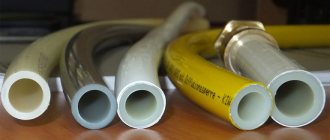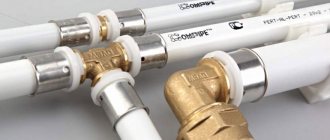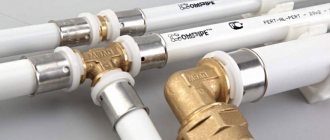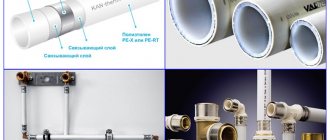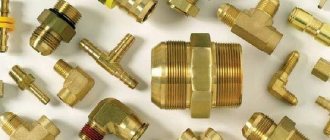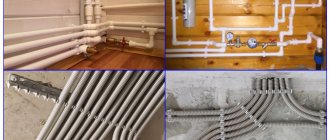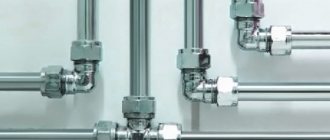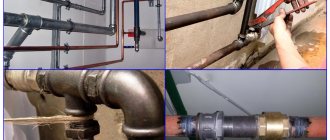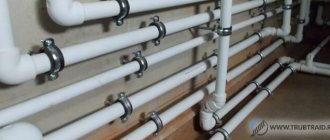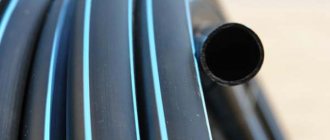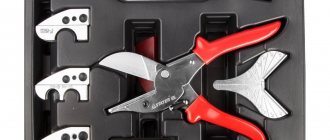When laying external water supply or heating systems, pipes made of cross-linked polyethylene, which replaced metal-plastic, are increasingly being used. The products are highly resistant to corrosion, so they can be installed directly into the ground. During their installation, shaped parts are used to create a permanent connection - fittings for cross-linked polyethylene, which provide increased strength and durability of the pipeline structure.
Metal-plastic is inferior to polyethylene in strength, tightness and other characteristics. So, cyclic freezing and thawing will not affect PEX in any way, but frozen water inside the metal-plastic structure can break it.
What is cross-linked polyethylene
This product is obtained by special processing (cross-linking) of polyethylene raw materials. As a result of the technological process, cross-linked polyethylene is formed, denoted by the abbreviation PEX. Compared to primary raw materials, it has improved characteristics, becoming more flexible, durable and heat-resistant.
Today, by cross-linking polyethylene, four types of cross-linked polyethylene are obtained: PEX-a, PEX-b, PEX-c, PEX-d. They differ in their operational properties:
- The most heat-resistant of them is PEX-a. It can withstand a maximum temperature of +90 ºC. At the same time, the polymer has high strength and flexibility.
- PEX-b is a common type of PEX polyethylene pipe. It can be multilayer, unlike PEX, and is characterized by wear resistance. However, it cannot be welded.
- A distinctive feature of PEX-c is its high environmental friendliness, which is why branches from it are widely used in the pharmaceutical and food industries. Its heat resistance for heating systems is insufficient - at ambient temperatures above +70 ºC it is not recommended to use Pex pipes.
- PEX-d are in low demand and difficult to manufacture.
You can determine whether what you have in front of you is cross-linked polyethylene yourself. You need to place a piece of the product in the oven and heat it to 180 degrees. If it has lost its shape or melted, this means it is a fake.
Any cross-linked polyethylene is characterized by a temperature memory effect, that is, when heated, it returns to its original shape after deformation.
Review of manufacturers and costs
It is important to purchase proven products from reliable manufacturers. Their enterprises must be equipped with modern equipment that allows them to produce a large volume of high-quality products in a wide range.
UPONOR
The well-known manufacturer Ononor produces PEX-a pipes under the Wisbo brand, the size range of which is 12-150 mm. The material for the manufacture of Vizbor shaped parts is PSU composite plastic. The metal parts of the fittings are made of “food grade” brass that is resistant to dezincification. The fittings are suitable for joining pipes with sizes from 16 to 44 mm.
STOUT
PEX-a pipes are produced under the Stout brand, which emerged as a result of cooperation between European and Russian specialists. The fittings are made of special brass (BS) and can be used for systems involving the transportation of drinking water. Shaped parts are produced in a wide range of different types of purposes, as well as axial ones.
ELSEN Systems
This company, which produces PEX-a (peroxide) pipes, provides the products with a protective layer of EVOH, which prevents the diffusion of oxygen. Elsen polymer fittings are made from high-quality PPSU composition. For threaded parts, a special grade of brass is used, which allows the products to be used for drinking water supply systems.
Push fittings are characterized by a special design of the pipe girth, which is called “Shark tooth”.
VALTEC
Valtec products are PEX-b pipe products, which do not have shape memory. Therefore, when joining them, clamps are used for additional fixation. Being light in weight, the products are quite easy to install. Typically used for low temperature heating. They are installed using a hidden installation method when installing heated floors, ceilings, and walls. The diameter of the fittings ranges from 16 to 20 mm.
Typically, large manufacturers of tubular products also supply their products with a set of fittings. If there is a need to purchase fittings separately, then it is advisable to buy products of the same brand (brand) as the pipes with which they will be installed. Despite the standardization of sizes, some discrepancies are still possible, and this can lead to a violation of the tightness of the connections.
Why cross-linked polyethylene is not welded
The main problem for any pipeline is the connection technology. Therefore, the disadvantages of PEX bends include their inability to be welded, in contrast to their competitors - polypropylene pipes.
Intermolecular modification in the form of a cross-linking process led to the loss of thermoelasticity, which is characteristic of conventional polyethylene. PEX cannot form a continuous bond on its own.
At welding temperature it stops melting and simply becomes elastomeric. Thus, having received increased heat resistance, cross-linked polyethylene lost its ability to be welded.
Pros and cons of cross-linked polyethylene pipes
According to experts, bends made from SP are superior in performance parameters to analogues made from any polymers, as evidenced by the ability to use them not only for cold water supply, but also in home heating and underfloor heating.
The main advantage of PEX over conventional polyethylene is the ability to function for a long time at a working temperature of +90 ºC (with the exception of PEX-c).
More advantages:
- Light specific gravity.
- No corrosion.
- Ability to restore configuration after fractures and temperature deformations.
- Resistance to both high and low temperatures, which makes it possible to lay heating pads from PEX pipes near buildings, in entrances.
- The minimum bending radius is 6 diameters, which makes laying heated floors easier.
The disadvantages of cross-linked polyethylene outlets include relatively high oxygen permeability, which leads to the appearance of rust in radiators and metal parts of the water supply system. This phenomenon is combated by applying a protective shell (EVOH) and reinforcement (products PEX-AL-PEX, PEX-AL-PE, PEX-AL-PP).
More cons:
- The thermal expansion of a PEX pipe is almost 8 times greater than that of a metal-plastic pipe.
- PEX is UV resistant.
- PEX has a high cost.
Types of fittings
Currently, three types of fittings are used for joining PEX bends:
- Compression (crimp).
- Press fittings.
- Axial.
Compression
This type of fitting is a detachable connection type. The fitting consists of a nut, a split ring and a fitting. The material used is often nickel-plated brass.
Press fittings
Press fittings create a permanent connection, which is distinguished by durability and increased strength.
They are used for screeding, when paving pipelines, in systems with high pressure and temperature.
The device includes a body, ferrules, and a sleeve. Crimping tool required: manual or electric crimping pliers.
Axial
Consists of a body with a fitting and a sleeve. During installation, two tools are used: expansion and tension.
Selection rules
When choosing fittings, the features of the installed system and the budget are taken into account. Usually, pipes are purchased first, and suitable fittings are already purchased for them. You should pay attention to the following points:
- their cross-sectional size must match the diameter of the pipes;
- metal fittings coated with zinc have increased anti-corrosion properties;
- parts must be free of sagging or roughness, and their seams must be carefully processed;
- The connection method is chosen taking into account the load that the part will experience.
All connectors must have clear and prominent markings on the body, as well as quality certificates, which are indicators of the authenticity of the products.
Where can I buy
Fittings are sold in the same place where cross-linked polyethylene pipes are sold. Online stores offer a wide selection. Specialists are ready to advise consumers and arrange delivery to any point in Russia.
approximate price
The cost of connectors depends on the functionality of the fitting and diameter dimensions.
The price range is small: from 100 to 150 rubles, for tees - over 200 rubles. But the cost of a coupling for connecting two pipes of different diameters (50×32) will already be 1842 rubles.
Connection methods
The connection option is selected depending on the pressure.
Compression
The compression method is universal and is used for connecting other types of pipes.
A nut, a ferrule, and the fitting itself are put on the outlet. This entire mechanism is tightened with a union nut. Subsequently, this nut must be tightened from time to time.
Using crimping
The pipe is cut at a right angle, cleaned, and a chamfer is formed. A crimp coupling is put on the outlet, and the press fitting fitting is inserted into the channel until it stops. Press pliers are used to crimp the coupling.
The tightness of the press fitting is maintained for the entire period of operation of the pipeline.
Press-on method
It is considered the most reliable connection for PEX pipes.
Produced using special devices.
Here are the options:
- First, a sleeve is placed on the outlet, moving it away from the edge. One of the tools—an expander with sliding handles—stretches the outlet hole by inserting a nozzle into it and pushing the handles of the device apart. Adjust the diameter of the inlet hole to a size that allows the fitting fitting to fit freely into it. Insert the fitting into the pipe until it stops, using a special lubricant if necessary. Move the press sleeve to the edge of the outlet, leaving a small gap. Then, with another tool - a tension press pliers - the sliding sleeve is pulled with force to the fitting.
- The fitting consists of a body with a fitting and a ring. During installation, one tool is used - an expander. After installing the ring on the outlet, the pipe and ring expand, and the fitting is inserted into the resulting socket. After a few minutes the connection is ready. An additional compacting effect occurs when using PEX pipes, which have shape memory.
How to choose a good fitting and install it
The markings on the case will tell a lot to the connoisseur. Those companies that make high-quality docking elements simply will not use cheap printed fixtures. Therefore, any inscription, even a single symbol, is printed clearly and expressively, excluding the slightest vagueness or misinterpretation
It is equally important to evaluate the weight of the structures, since normal fittings are made from selected brass. If someone tries to claim that lightweight products are just as valuable, this is just a clever marketing ploy or some kind of misunderstanding
It is worth taking a closer look at the appearance of the fitting. If it is made of a thin layer of metal, it will not be possible to obtain a reliable joint. Professionals confidently say that by purchasing cheap elements from small retail outlets, especially those operating unofficially, people doom themselves to re-laying the pipeline. In this regard, investing in a high-quality and expensive variety of components is more than justified.
Using a gauge, the ovality that inevitably occurs during the cut is corrected. Following this, the inside is chamfered using a chamfer remover or a sharp knife. If you use a simple knife, you will still have to refine the desired area with sandpaper. Only when all this has been done can you thread the fitting onto the pipe, making sure to check whether it is seated tightly. There are models that do not require fastening of crimp couplings. Then these same couplings are placed on the pipe and a fitting is inserted into the part, on top of which sealing rings are fixed. At the points of contact between a metal-plastic pipe and a metal element, an insulating gasket is required to protect against electrochemical corrosion.
When connecting fittings of various designs, the sleeve is captured in a clamp and brought together until the handles stop. When the work is done well, the metal part becomes arched, and the fitting receives a pair of identical strips in the shape of a ring. Processing must be completed in one go. The crimping should not be repeated. This will only cause damage to the connection, so the defect will be irreversible. Therefore, you should prepare for work carefully and take into account all the smallest nuances, freeing up time so that nothing interferes.
Such connections, if done properly, can be of no less quality than when using welding - and their tightness satisfies all requirements. It is recommended to use fittings of the same brand as the pipes being connected. If the choice has not yet been made, you can safely use designs from Henko, Valtec. The products of these concerns are of high quality and are very popular. It is easy to use such parts even for beginners.
The fitting for a steel pipeline does not have a fitting; it is just a sleeve itself, which is crimped with pliers. An attempt to compress a metal-plastic pipe without a softening “intermediary” will end in its deformation.
In the next video you will see the principle of working with press fittings for Valtec stainless pipes.
Features of installation of fittings
Before starting installation work, it is necessary to draw a pipeline laying diagram. On it indicate the connection points, names and parameters of the fittings and taps used. According to the drawing, the amount of material is determined.
Then the tools are prepared: scissors for cutting bends, depending on the joining method - adjustable wrenches or a set of pressing tools.
PEX pipes are used for heating only in a network that is set to a working environment temperature of 90 °C.
To guarantee the operation of the entire assembled system, it is recommended to purchase PEX pipes and axial fittings from the same manufacturer and observe correct installation.
Basic installation errors
Repairing fittings is usually not done. It is easier to fix any malfunction in the assembly by replacing the connector. But many problems and difficulties can be avoided during installation. You should work in a prepared place; debris and dirt should not get into the joints.
Before work, you should prepare a pipeline diagram in order to immediately lay out the required number of fittings. And secure the pipes to the wall or floor in advance with special holder clips, since due to the high plasticity of polyethylene they will constantly return to their original position.
The quality of installation depends on the pipe cut. Its plane should be perpendicular to the longitudinal axis, and the edges should be as smooth as possible - without cuts, burrs or waves. The strength and tightness of the connection depends on this.
Is it worth seeking help from specialists?
By turning to the services of professionals, the consumer will save time and nerves, and avoid possible mistakes when arranging the plumbing or heating system at home.
At the same time, if you have the necessary tools and study the assembly technology, you can install the pipeline yourself. Installation of channels made of cross-linked polyethylene and fittings for them is not particularly difficult; high qualifications and special equipment are not required. The subsequent operation of the assembled system will not cause any difficulties.
Advantages
The bar for the mixer is polypropylene.
The nozzles can have both internal and external threads. Thanks to the unified dimensions, it is possible to connect metal-plastic parts to the copper sections of the mains. Provided that the fittings are installed correctly, it is possible to ensure a very high-quality permanent connection. It is distinguished by its mechanical strength (at the joining points, the working pressure easily reaches 10 atm without any risk to the part). Long-term use of the fitting is another advantage.
Manufacturers most often provide a 50-year guarantee, but only if all manipulations with the product comply with technological standards. The compression fitting is better than other designs also because it does not require mandatory supervision and maintenance. This is very good when hidden lines are installed or concrete is poured. Such connections do not lose their practical advantages even with thermal expansion. Therefore, they can be safely used even in heating systems and in DHW circuits; this will not cause any problems for the consumer.
The installation itself is easy and quick, eliminating the need to master specific tools or special training. Such manipulations are accessible even to beginners; the only tools they will need are crimping pliers. By using fittings, you can reduce the total number of pipes and additional fittings. Therefore, the total costs of installing a water supply or heating system are lower. The general coincidence of the terms of use of the fitting and the metal-plastic pipeline allows them to synchronize their repair and replacement.
Even where there is a very strong corrosive environment, press fittings are guaranteed to withstand. They retain this property throughout the entire operational period. The developers were able to achieve their optimal use for the circulation of both cold and very hot (by domestic standards) water.
